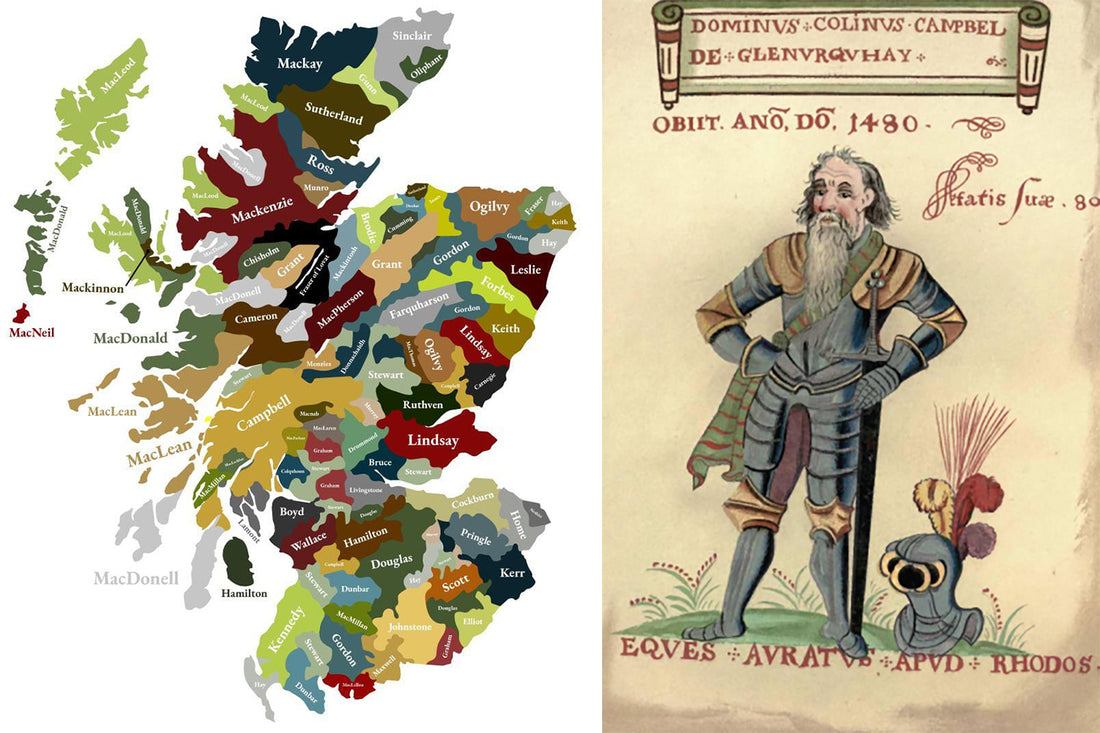About 30% of Scottish families are attached to a clan.
Clans in Scotland emerged primarily during the Middle Ages, evolving from extended families or kinship groups. These clans often shared a common ancestor and territory, which formed the basis of their identity. The word "clan" itself is derived from the Gaelic clann meaning "children" or "offspring", emphasising the familial nature of these groups.
Clans were typically led by a chief, who held considerable authority over clan affairs. The chief was often chosen based on lineage and hereditary right, although leadership could also be contested or conferred through other means.
Clans developed distinct symbols and heraldic devices to represent their identity. These included crests, mottoes, tartans, and badges, which were often displayed on clothing, banners, and other paraphernalia. The tartan, in particular, became closely associated with Scottish clans, although its significance predates the clan system itself.
Clans frequently engaged in conflict with rival clans and external foes. Inter-clan warfare was common, driven by factors such as territorial disputes, political allegiances, and personal vendettas. The Scottish Highlands, in particular, saw frequent skirmishes and battles between rival clans. Feuding often persisted for generations, shaping the social and political dynamics of the region.
The decline of the clan system began in earnest in the 18th and 19th centuries, accelerated by factors such as the Jacobite uprisings, the Highland Clearances, and the Act of Union between Scotland and England in 1707. These events undermined the traditional authority of clan chiefs and eroded the economic and social foundations of clan society. The wearing of tartan, for example, was banned following the Jacobite rebellions but later revived during the Victorian era as part of a romanticised view of Scottish culture.
In the 19th and 20th centuries, there was a resurgence of interest in Scottish clan heritage, driven in part by the efforts of organisations such as the Highland Society of London and the Royal Celtic Society. Clan societies were established worldwide, particularly in countries with large Scottish diaspora populations, such as the United States, Canada, Australia, and New Zealand. Today, many people of Scottish descent maintain connections to their clan heritage through participation in clan societies, attendance at Highland games, and other cultural events.
The most notable clan event of recent times was The Gathering 2009 in Edinburgh, which attracted at least 47,000 participants from around the world, simultaneously marking the 250th birthday of its favourite son, the poet Robert Burns. Kitted out in perhaps the world's best-known national dress, the clans are meeting to discuss the future of the clan system in the 21st century and the role of the clan chief.
Overall, Scottish clans remain an enduring symbol of Scotland's cultural identity, representing a unique blend of familial loyalty, martial tradition, and cultural pride.
Story Idea: Remo Giuffré
____________________________
References
wikipedia.org/wiki/Scottish_clan
independent.co.uk/news/uk/home-news/edinburgh-sees-the-largest-ever-gathering-of-clan-chiefs
Images
1. Scottish map of clans and a 16th or 17th century illustration depicting Colin Campbell of Glenorchy (died 1480).
2. Video: History of Scottish clans timelapse: Every year from 834 to 1707
3. The Atholl Highlanders tug of war. Credit: Kenny Lam.
4. MacArthur tartan, as published in the Vestiarium Scoticum.
5. The Gathering 2009, Edinburgh. Credit: David Cheskin / PA







































































































